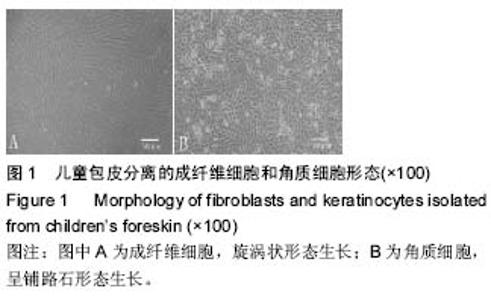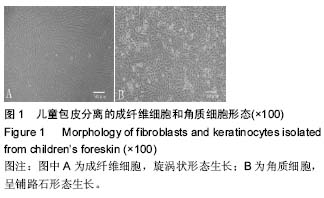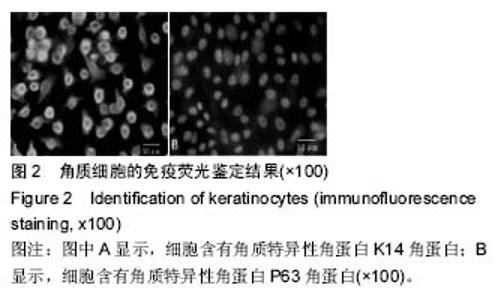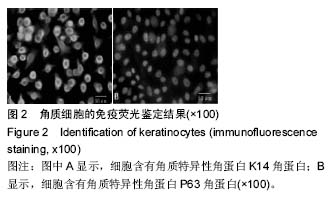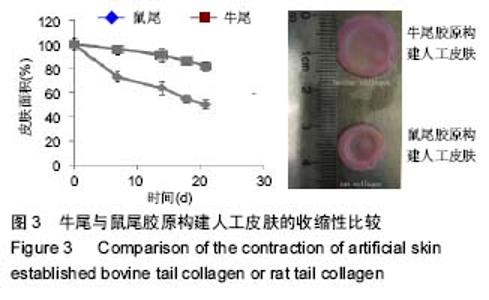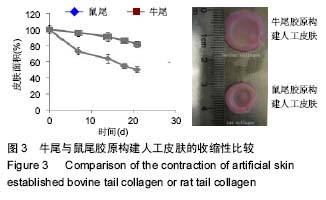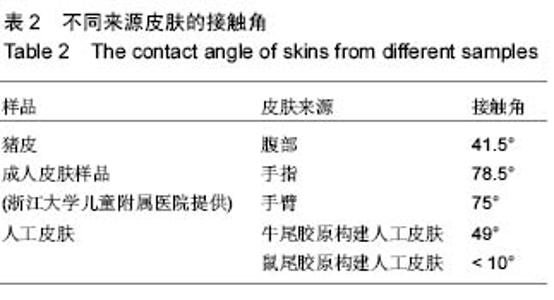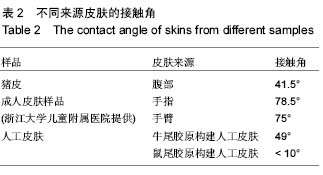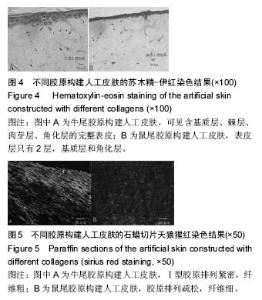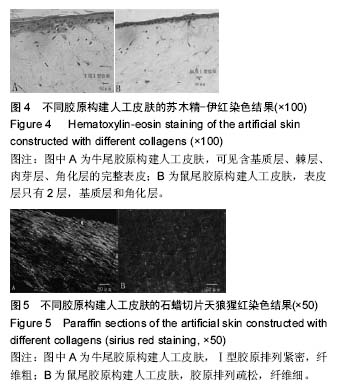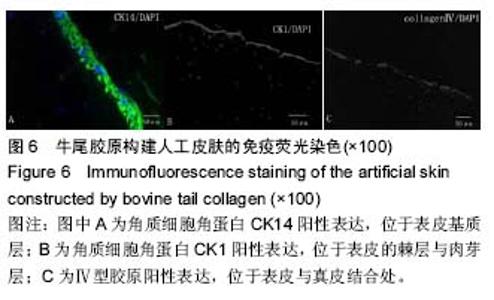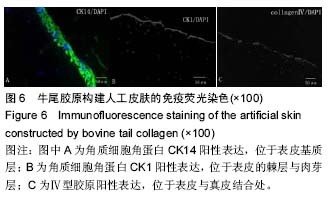Chinese Journal of Tissue Engineering Research ›› 2016, Vol. 20 ›› Issue (46): 6915-6921.doi: 10.3969/j.issn.2095-4344.2016.46.010
Previous Articles Next Articles
Artificial skin preparation using three-dimensional printing in vitro
Liu Yu, Shen Chong, Meng Qin
- School of Chemical Engineering and Biological Engineering, Zhejiang University, Hangzhou 310027, Zhejiang Province, China
-
Received:2016-09-03Online:2016-11-11Published:2016-11-11 -
Contact:Meng Qin, Professor, School of Chemical Engineering and Biological Engineering, Zhejiang University, Hangzhou 310027, Zhejiang Province, China -
About author:Liu Yu, Master, School of Chemical Engineering and Biological Engineering, Zhejiang University, Hangzhou 310027, Zhejiang Province, China -
Supported by:the National Natural Science Foundation of China, No. 21476197
CLC Number:
Cite this article
Liu Yu, Shen Chong, Meng Qin. Artificial skin preparation using three-dimensional printing in vitro[J]. Chinese Journal of Tissue Engineering Research, 2016, 20(46): 6915-6921.
share this article
| [1] Bouwstra JA,Honeywell-Nguyen PL.Skin structure and mode of action of vesicles.Adv Drug Deliv Rev.2002;54 Suppl 1:S41-55. [2] Green H,Kehinde O,Thomas J.Growth of cultured human epidermal cells into multiple epithelia suitable for grafting. Proc Natl Acad Sci U S A. 1979;76(11): 5665-5668. [3] Bell E,Ivarsson B,Merrill C.Production of a tissue-like structure by contraction of collagen lattices by human fibroblasts of different proliferative potential in vitro. Proc Natl Acad Sci U S A.1979;76(3):1274-1278. [4] Lee V,Singh G,Trasatti JP,et al.Design and fabrication of human skin by three-dimensional bioprinting.Tissue Eng Part C Methods.2014;20(6):473-484. [5] Koch L,Deiwick A,Schlie S,et al.Skin tissue generation by laser cell printing.Biotechnol Bioeng.2012;109(7): 1855-1863. [6] Bell E, Ehrlich HP, Buttle DJ,et al.living tissue formed in vitro and accepted as a full thickness skin equivalent. Science.1981;211(4486):1052-1054. [7] Aasen T,Izpisúa Belmonte JC.Isolation and cultivation of human keratinocytes from skin or plucked hair for the generation of induced pluripotent stem cells.Nat Protoc. 2010;5(2):371-382. [8] Carlson MW,Alt-Holland A,Egles C,et al.Three- Dimensional Tissue Models of Normal and Diseased Skin.Curr Protoc Cell Biol.2008;Chapter 19:Unit 19.9. [9] Dragúňová J,Kabát P,Koller J,et al.Experience gained during the long term cultivation of keratinocytes for treatment of burns patients.Cell Tissue Bank. 2012; 13(3):471-478. [10] Woodcock-Mitchell J,Eichner R,Nelson WG,et al.Immunolocalization of keratin polypeptides in human epidermis using monoclonal antibodies.J Cell Biol. 1982; 95(2 Pt 1):580-588. [11] Papini S,Cecchetti D,Campani D,et al.Isolation and Clonal Analysis of Human Epidermal Keratinocyte Stem Cells in Long-Term Culture.Stem Cells.2003; 21(4):481-494. [12] Lane EB.Monoclonal antibodies provide specific intramolecular markers for the study of epithelial tonofilament organization.J Cell Biol.1982;92(3):665-673. [13] Rajan N,Habermehl J,Coté MF,et al.Preparation of ready-to-use, storable and reconstituted type I collagen from rat tail tendon for tissue engineering applications. Nat Protoc.2006;1(6):2753-2758. [14] Tamilmozhi S,Veeruraj A,Arumugam M.Isolation and characterization of acid and pepsin-solubilized collagen from the skin of sailfish (Istiophorus platypterus). Food Res Int.2013;54:1499-1505. [15] Techatanawat S.Type I collagen extracted from rat-tail and bovine Achilles tendon for dental application: a comparative study.Asian Biomed.2011;5:787. [16] Laemmli UK.Cleavage of structural proteins during the assembly of the head of bacteriophage T4.Nature. 1970;227(5259):680-685. [17] Junqueira L,Cossermelli W,Brentani R.Differential staining of collagens type I, II and III by Sirius Red and polarization microscopy.Arch Histol Jpn. 1978;41(3):267-274. [18] 王雪,金剑,肖长发.疏水改性聚对苯二甲酸乙二醇酯的合成与表征[J].纺织学报,2011,32(4):12-17. [19] Koster MI,Roop DR.The role of p63 in development and differentiation of the epidermis: Tanioku kihei memorial lecture.J Dermatol Sci.2004;34(1):3-9. [20] Nelson WG,Sun TT.The 50-and 58-kdalton keratin classes as molecular markers for stratified squamous epithelia: cell culture studies.J Cell Biol.1983;97(1):244-251. [21] Yang A,Kaghad M,Wang Y,et al.p63, a p53 homolog at 3q27–29, encodes multiple products with transactivating, death-inducing, and dominant-negative activities.Mol Cell. 1998;2(3):305-316. [22] Liu SC,Karasek M.Isolation and growth of adult human epidermal keratinocytes in cell culture.J Invest Dermatol.1989;92(4 Suppl):164S;discussion 165S. [23] Tenchini M,Ranzati C,Malcovati M.Culture techniques for human keratinocytes. Burns.1992;18:S11-S16. [24] Tsao MC, Walthall BJ, Ham RG.Clonal growth of normal human epidermal keratinocytes in a defined medium.J Cell Physiol.1982;110(2):219-229. [25] Zare S,Zarei MA,Ghadimi T,et al.Isolation, cultivation and transfection of human keratinocytes.Cell Biol Int. 2014;38(4):444-451. [26] Pajoum Shariati SR,Shokrgozar MA,Vossoughi M, et al.In vitro co-culture of human skin keratinocytes and fibroblasts on a biocompatible and biodegradable scaffold.Iran Biomed J.2009;13(3):169-177. [27] Lam PK,Chan ES,To EW,et al.Development and evaluation of a new composite Laserskin graft.J Trauma.1999;47(5):918-922. [28] Rheinwatd JG,GreenH.Seria cultivation of strains of human epidemal keratinocytes: the formation keratinizin colonies from single cell is.Cell.1975;6:331-343. [29] 汪培铭.不同细胞滋养层对人角朊细胞体外培养的影响[D].第四军医大学,2004. [30] Zheng L,Fan HS,Sun J,et al.Chondrogenic differentiation of mesenchymal stem cells induced by collagen‐based hydrogel: An in vivo study.J Biomed Mater Res A. 2010;93(2):783-792. [31] Gentleman E,Lay AN,Dickerson DA,et al.Mechanical characterization of collagen fibers and scaffolds for tissue engineering.Biomaterials.2003;24(21):3805-3813. [32] Silver FH,Trelstad RL.Type I collagen in solution. Structure and properties of fibril fragments.J Biol Chem. 1980;255(19):9427-9433. [33] 余海,廖小宜.鼠尾肌腱胶原蛋白的提取及凝胶的制备[J].海南医学,2000,11(3):64-65. [34] Baselt DR,Revel JP,Baldeschwieler JD.Subfibrillar structure of type I collagen observed by atomic force microscopy.Biophys J.1993;65(6):2644-2655. [35] EHRMANN RL, GEY GO.The growth of cells on a transparent gel of reconstituted rat-tail collagen.J Natl Cancer Inst.1956;16(6):1375-1403. [36] Andujar M,Melin M,Guerret S,et al.Cell migration influences collagen gel contraction.J Submicrosc Cytol Pathol.1992;24(2):145-154. [37] Chau DY,Johnson C,MacNeil S,et al.The development of a 3D immunocompetent model of human skin. Biofabrication.2013;5(3):035011. [38] 38Vörsmann H,Groeber F,Walles H,et al.Development of a human three-dimensional organotypic skin-melanoma spheroid model for in vitro drug testing. Cell Death Dis. 2013 ;4:e719. [39] Wojtowicz AM,Oliveira S,Carlson MW,et al.The importance of both fibroblasts and keratinocytes in a bilayered living cellular construct used in wound healing. WoundRepair Regen.2014;22(2):246-255. [40] 40Janson D,Rietveld M,Willemze R,et al.Effects of serially passaged fibroblasts on dermal and epidermal morphogenesis in human skin equivalents. Biogerontology. 2013;14(2):131-140. [41] Junqueira LC,Bignolas G,Brentani RR.Picrosirius staining plus polarization microscopy, a specific method for collagen detection in tissue sections. Histochem J. 1979;11(4):447-455 |
| [1] | Pu Rui, Chen Ziyang, Yuan Lingyan. Characteristics and effects of exosomes from different cell sources in cardioprotection [J]. Chinese Journal of Tissue Engineering Research, 2021, 25(在线): 1-. |
| [2] | Zhang Tongtong, Wang Zhonghua, Wen Jie, Song Yuxin, Liu Lin. Application of three-dimensional printing model in surgical resection and reconstruction of cervical tumor [J]. Chinese Journal of Tissue Engineering Research, 2021, 25(9): 1335-1339. |
| [3] | Shen Jinbo, Zhang Lin. Micro-injury of the Achilles tendon caused by acute exhaustive exercise in rats: ultrastructural changes and mechanism [J]. Chinese Journal of Tissue Engineering Research, 2021, 25(8): 1190-1195. |
| [4] | Liang Xueqi, Guo Lijiao, Chen Hejie, Wu Jie, Sun Yaqi, Xing Zhikun, Zou Hailiang, Chen Xueling, Wu Xiangwei. Alveolar echinococcosis protoscolices inhibits the differentiation of bone marrow mesenchymal stem cells into fibroblasts [J]. Chinese Journal of Tissue Engineering Research, 2021, 25(7): 996-1001. |
| [5] | Duan Liyun, Cao Xiaocang. Human placenta mesenchymal stem cells-derived extracellular vesicles regulate collagen deposition in intestinal mucosa of mice with colitis [J]. Chinese Journal of Tissue Engineering Research, 2021, 25(7): 1026-1031. |
| [6] | Zeng Yanhua, Hao Yanlei. In vitro culture and purification of Schwann cells: a systematic review [J]. Chinese Journal of Tissue Engineering Research, 2021, 25(7): 1135-1141. |
| [7] | Xu Dongzi, Zhang Ting, Ouyang Zhaolian. The global competitive situation of cardiac tissue engineering based on patent analysis [J]. Chinese Journal of Tissue Engineering Research, 2021, 25(5): 807-812. |
| [8] | Wu Zijian, Hu Zhaoduan, Xie Youqiong, Wang Feng, Li Jia, Li Bocun, Cai Guowei, Peng Rui. Three-dimensional printing technology and bone tissue engineering research: literature metrology and visual analysis of research hotspots [J]. Chinese Journal of Tissue Engineering Research, 2021, 25(4): 564-569. |
| [9] | Chang Wenliao, Zhao Jie, Sun Xiaoliang, Wang Kun, Wu Guofeng, Zhou Jian, Li Shuxiang, Sun Han. Material selection, theoretical design and biomimetic function of artificial periosteum [J]. Chinese Journal of Tissue Engineering Research, 2021, 25(4): 600-606. |
| [10] | Liu Liu, Zhou Qingzhu, Gong Zhuo, Liu Boyan, Yang Bin, Zhao Xian. Characteristics and manufacturing techniques of collagen/inorganic materials for constructing tissue-engineered bone [J]. Chinese Journal of Tissue Engineering Research, 2021, 25(4): 607-613. |
| [11] | Liu Fei, Cui Yutao, Liu He. Advantages and problems of local antibiotic delivery system in the treatment of osteomyelitis [J]. Chinese Journal of Tissue Engineering Research, 2021, 25(4): 614-620. |
| [12] | Li Xiaozhuang, Duan Hao, Wang Weizhou, Tang Zhihong, Wang Yanghao, He Fei. Application of bone tissue engineering materials in the treatment of bone defect diseases in vivo [J]. Chinese Journal of Tissue Engineering Research, 2021, 25(4): 626-631. |
| [13] | Zhang Zhenkun, Li Zhe, Li Ya, Wang Yingying, Wang Yaping, Zhou Xinkui, Ma Shanshan, Guan Fangxia. Application of alginate based hydrogels/dressings in wound healing: sustained, dynamic and sequential release [J]. Chinese Journal of Tissue Engineering Research, 2021, 25(4): 638-643. |
| [14] | Chen Jiana, Qiu Yanling, Nie Minhai, Liu Xuqian. Tissue engineering scaffolds in repairing oral and maxillofacial soft tissue defects [J]. Chinese Journal of Tissue Engineering Research, 2021, 25(4): 644-650. |
| [15] | Xing Hao, Zhang Yonghong, Wang Dong. Advantages and disadvantages of repairing large-segment bone defect [J]. Chinese Journal of Tissue Engineering Research, 2021, 25(3): 426-430. |
| Viewed | ||||||
|
Full text |
|
|||||
|
Abstract |
|
|||||
